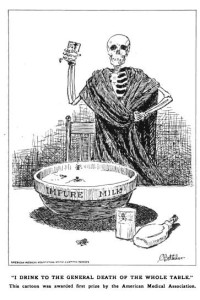The U.S. Centers for Disease Control reports that a total of 99 cases (59 confirmed and 40 probable) of campylobacteriosis, including 10 patients who were hospitalized, and one who died, occurred in an outbreak in northern Utah associated with a single raw milk dairy.
 The outbreak was documented by epidemiologic, environmental, and laboratory evidence. Despite routine testing of raw milk showing results within acceptable limits, the milk still contained dangerous bacteria.
The outbreak was documented by epidemiologic, environmental, and laboratory evidence. Despite routine testing of raw milk showing results within acceptable limits, the milk still contained dangerous bacteria.
To limit outbreaks from raw milk consumption, more reliable routine tests are needed that do not rely solely on bacterial, coliform, and somatic cell counts. Case investigation and pulsed-field gel electrophoresis patterns from environmental samples can support an epidemiologic link and allow implementation of control measures.
In May 2014, the Utah Public Health Laboratory (UPHL) notified the Utah Department of Health (UDOH) of specimens from three patients infected with Campylobacter jejuni yielding indistinguishable pulsed-field gel electrophoresis (PFGE) patterns. All three patients had consumed raw (unpasteurized and nonhomogenized) milk from dairy A. In Utah, raw milk sales are legal from farm to consumer with a sales permit from the Utah Department of Agriculture and Food (UDAF). Raw milk dairies are required to submit monthly milk samples to UDAF for somatic cell and coliform counts, both of which are indicators of raw milk contamination. Before this cluster’s identification, dairy A’s routine test results were within acceptable levels (<400,000 somatic cells/mL and <10 coliform colony forming units/mL). Subsequent enhanced testing procedures recovered C. jejuni, a fastidious organism, in dairy A raw milk; the isolate matched the cluster pattern. UDAF suspended dairy A’s raw milk permit during August 4–October 1, and reinstated the permit when follow-up cultures were negative. Additional cases of C. jejuni infection were identified in October, and UDAF permanently revoked dairy A’s permit to sell raw milk on December 1. During May 9–November 6, 2014, a total of 99 cases of C. jejuni infection were identified. Routine somatic cell and coliform counts of raw milk do not ensure its safety. Consumers should be educated that raw milk might be unsafe even if it meets routine testing standards.
